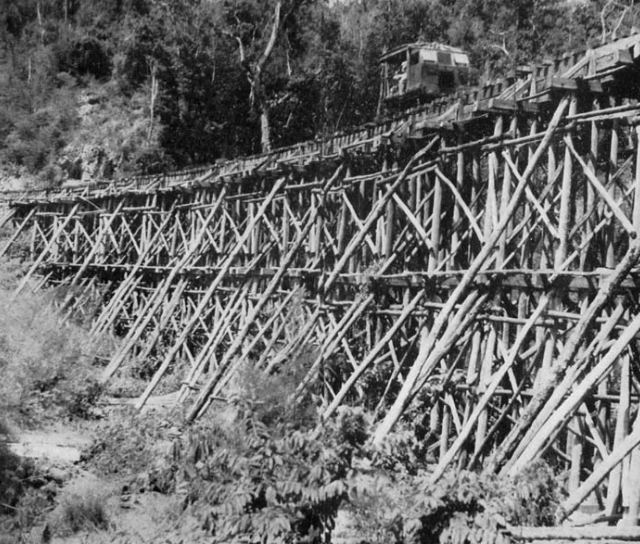Chungkai War Cemetery
Five kilometres west of Kanchanaburi, is the Chungkai War Cemetery. It is the smallest of the three cemeteries which are the final resting place of those POWs who died while working on the Burma-Thailand Railway. Read the fascinating story of this little known, seldom visited but important part of the Railway story.
The Start of Construction of the Burma-Thailand Railway
October 2024 marks the 82nd anniversary of the ‘official’ start of construction of the Burma-Thailand Railway. Something that would be an engineering success but resulting in the needless loss of so many lives.
Prisoners of the Japanese
Following the Fall of Singapore and the capture of territories and islands in the South-Western Pacific, tens of thousands of Australian, British and Dutch soldiers became prisoners of the Japanese (POWs). The Japanese had not planned for such large numbers of POWs and was not a signatory to the Geneva Convention which set-out rules on the treatment of POWs. So what did the Japanese do?
Private Harold Martin
Private Harold Martin joined the army in late 1940, he was 23 at the time and left behind a wife and young son. Like so many men of that time, he felt “It was the right thing to do” to fight for his country. In late 1941, he was sent to Singapore as part of the Australian commitment to the British Garrison. On the 15th February 1942, he was amongst the 15,000 Australian soldiers who became prisoners of war (POW’s) of the Japanese in the Fall of Singapore.
Private Robert Goulden
Private Goulden was amongst the first Australians to be sent to Burma to work as forced labour for the Japanese. Escape from a Japanese work camps for Allied and Dutch POW’s was difficult. But against all the odds, Private Goulden would attempt an escape to get back to his young wife in Australia. It would have tragic consequences.
Anzac Day Dawn Service at Hellfire Pass, Thailand
Each Anzac Day, in the pre-dawn darkness surrounded by jungle, more than 500 mostly Australians, gather for the Dawn Service at a disused section of the Burma-Thailand Railway, known as Hellfire Pass.
Nong Pladuc POW Camp
In the construction of the Burma-Thailand Railway during World War 2, allied POW camps made of thatched huts and usually with dirt floors, were built at regular intervals along the railway. In most cases, as each section of the railway was finished, the camp was vacated and was either dismantled by locals or allowed to be consumed by the jungle.
Private Mick Johnston
On Anzac Day (25th April) and Remembrance Day (11th November) each year, we reflect on those brave men and women who gave there lives in the defense of our country. We also remember those who have gone to war, returned, but suffered the physical and mental anguish of their duty.
In 2009, while undertaking family history research, I found a forgotten member of the family who died in World War 2 while working as a POW on the Burma-Thailand Railway.
7 Metre Embankment, 3 Tier Bridge & Hintok Cutting
The are many sites along the Burma-Thailand Railway where you can only be amazed by the construction ability of the men who built them. Sites like the Bridge over the River Kwai, the Wang Pho Viaduct and the railway cutting known as Hellfire Pass. Without exception, these sites were constructed with little more than hand tools and the sweat of the POW’s who laboured under the harsh treatment of the Japanese for long hours each day.
Cemeteries of the Burma-Thailand Railway
By the end of World War 2, over twelve thousand Allied and Dutch POW’s had died while working on the Burma-Thailand Railway with the vast majority of deaths occurring during the construction phase in 1942 and 1943.
The Railway after the War
Whenever I visit the Burma-Thailand Railway, I am always on the lookout for something that adds a little extra to the story of the Railway now nearly 75 years old. On a recent visit, at Namtok Railway Station, almost at the end of the current operating section of the Railway, I found an old framed black and white photo taken back in 1955, showing the reconstruction of the Bridge over the River Kwai which was badly damaged by allied bombing during the war.
Bombing of the Bridge over the River Kwai
The Bridge over the River Kwai at Tha Markham in Thailand, consisted of two bridges, one a temporary wooden trestle bridge first completed in February 1943 and the other, a high-level steel bridge completed in May of the same year.
Movie review: Bridge on the River Kwai
Most would have heard of or even seen the movie, The Bridge on the River Kwai. It was based on the novel of the same name written by Pierre Boulle. The movie tells the story of the relationship between a British Colonel (Colonel Nicholson) in charge of a group of POWs and a Japanese Officer (Colonel Saito) in charge of the camp and with the responsibility of building a railway bridge across the River Kwai.













